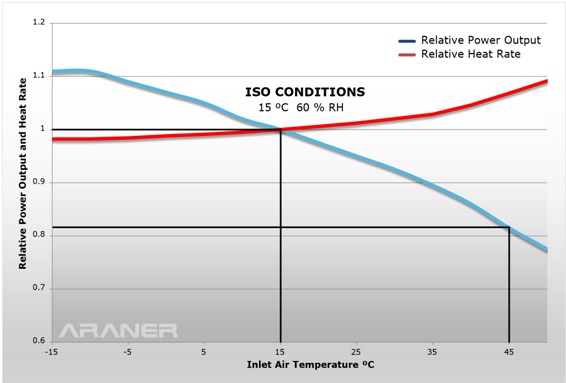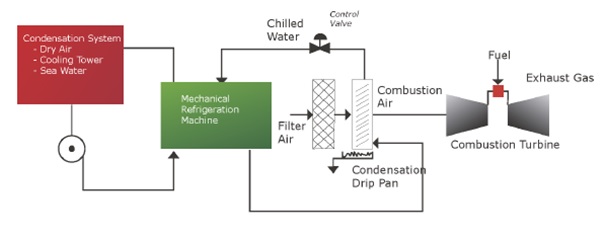The last two centuries have seen global energy demand increase significantly, spurred by the industrial and transportation sectors. We are now in the middle of the energy crisis as nonrenewable energy resources near exhaustion. The specific causes of this crisis are a ballooning population, energy overuse, energy wastage and deteriorating infrastructure. The need for prudent energy management, not only on the demand side, but also on the power generation side, has never been more necessary. Weather patterns can affect energy management for power plants and give plant managers sleepless nights. A series of fierce summer heatwaves in 2018 prompted many power plants across Asia, Europe, and America to either scale down operations or close altogether. For thermal power plants, temperature elevations beyond particular points are the worst nightmare. Fortunately, there are innovations to counter the negative effects of high ambient temperature of summer.
Temperature and Thermal Power Plant Operation
During summer, air and water temperatures change and consequently affect turbine efficiency in a thermal power plant. Elevated ambient air temperature results in reduced generation efficiency. The result of this is a slump in power generation. Since this reduction often coincides with peak power demand in summer, a crisis may occur, unless there is power recovery. Thermal power plants have cooling systems that are dependent on water. During summer, water temperatures rise and jeopardize the operation of these systems. It becomes a challenge for the affected facilities to maintain water quality regulations. Thermal power plants may apply advanced cooling solutions to stop or reduce dependency on freshwater supply. Water-scare regions across the world have discovered dry cooling technologies. The best solutions providers are able to apply these technologies without hampering overall power plant efficiency.
Natural Gas Power Plants: Dispatchable but Weather Dependent
For coal and other heavy-carbon fuels, the assumption that fossil fuel capacity is reducing with expansion of renewable energy applies. Natural gas is going against the tide by remaining clean and low cost. It is actually applicable for closing the gap between the expected generation mix and the conventional generation mix. In the United States, there are proposals for more gas-powered turbine plants to enhance dispatchable capacity. The US Energy Information Administration (EIA) reports that as of 2018, there was a total of 37GW nameplate capacity proposed, which is approximately 10% of the total combustion turbine capacity. There is a weather factor though. Combustion turbines tend to have lower capacity during summer days. Aero-derivative and heavy-duty gas turbines are constant volumetric airflow devices. Power output from these machines is directly proportional to air mass flow and therefore to air density. When ambient air temperature is higher, air density decreases resulting in decreased turbine power output. The specific mass varies with the mass flow rate of the air that enters the turbine’s compressor. This means that the mass flow rate is dependent on relative humidity, temperature, and other ambient conditions.

Fig 1: Power Output/Heat Rate against Inlet Air Temperature for Typical Turbine
This further means that rated capacity of the power plants may not be achievable, unless an energy recovery solution is identified in response to weather challenge. We can see this fact from the EIA data, which indicates a 57GW deficit when rated capacity is compared to installed capacity for 4,000 units.
The Solution, Turbine Inlet Air Cooling
During summer, power plants use a technology that mimics cold ambient conditions for a gas turbine. In TIAC settings, a single turbine or group of turbines is typically set up to operate for a limited period annually, for covering peak demand. Evaporative cooling happens to be the most common TIAC technology but many times it is not the optimum solution. Alternatively, there are advanced power technologies that use refrigerated systems for TIAC. Sometimes, these systems are combined with thermal energy storage (TES) to minimize operation time. Turbine efficiency in a thermal power plant is already impressive with TIAC in a simple combustion turbine. However, the introduction of waste heat recovery in a thermal power plant can be a great efficiency boost in a combined cycle system because there is minimal exhaust waste. The heat rate in heat recovery power plant is superior to that in simple cycle peaking power plant. TIAC from ARANER is not restricted to simple and combined cycle systems. It can also be applied for cogeneration and mechanical drive applications. ARANER often recommends the Mechanical vapor compression TIAC system with a TES tank, as it is usually the best technical solution available for power recovery in thermal power plants.

Fig 2: Mechanical Vapor Compression TIAC System by ARANER
Conclusion
If you are looking to have optimum power recovery in summer periods in a power plant, then TIAC is the answer. ARANER’s approach is based on determination of several crucial parameters that include ambient conditions, heat rejection type and thermal energy storage. You can download and read this eBook about TIAC plant configuration for advanced technology and power industries. Get in touch for even more insights into this amazing technology that optimizes thermal power plant performance.










